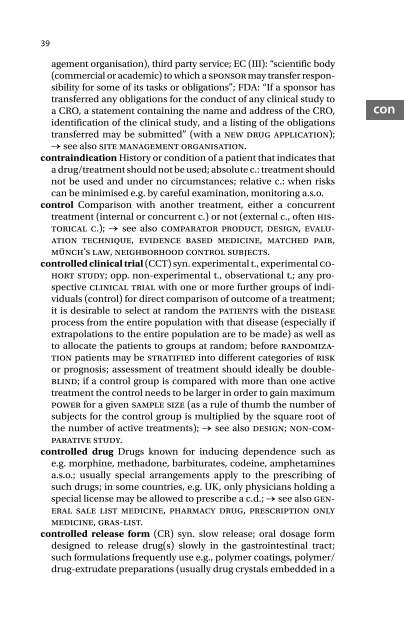220-Dictionary of Pharmaceutical Medicine, 2nd Edition-Gerhard Nahler Annette Mollet-3211898352-S
220-Dictionary of Pharmaceutical Medicine, 2nd Edition-Gerhard Nahler Annette Mollet-3211898352-S
220-Dictionary of Pharmaceutical Medicine, 2nd Edition-Gerhard Nahler Annette Mollet-3211898352-S
Create successful ePaper yourself
Turn your PDF publications into a flip-book with our unique Google optimized e-Paper software.
39agement organisation), third party service; EC (III): “scientific body(commercial or academic) to which a sponsor may transfer responsibilityfor some <strong>of</strong> its tasks or obligations”; FDA: “If a sponsor hastransferred any obligations for the conduct <strong>of</strong> any clinical study toa CRO, a statement containing the name and address <strong>of</strong> the CRO,identification <strong>of</strong> the clinical study, and a listing <strong>of</strong> the obligationstransferred may be submitted” (with a new drug application);→ see also site management organisation.contraindication History or condition <strong>of</strong> a patient that indicates thata drug/treatment should not be used; absolute c.: treatment shouldnot be used and under no circumstances; relative c.: when riskscan be minimised e.g. by careful examination, monitoring a.s.o.control Comparison with another treatment, either a concurrenttreatment (internal or concurrent c.) or not (external c., <strong>of</strong>ten historicalc.); → see also comparator product, design, evaluationtechnique, evidence based medicine, matched pair,münch’s law, neighborhood control subjects.controlled clinical trial (CCT) syn. experimental t., experimental cohortstudy; opp. non-experimental t., observational t.; any prospectiveclinical trial with one or more further groups <strong>of</strong> individuals(control) for direct comparison <strong>of</strong> outcome <strong>of</strong> a treatment;it is desirable to select at random the patients with the diseaseprocess from the entire population with that disease (especially ifextrapolations to the entire population are to be made) as well asto allocate the patients to groups at random; before randomizationpatients may be stratified into different categories <strong>of</strong> riskor prognosis; assessment <strong>of</strong> treatment should ideally be doubleblind;if a control group is compared with more than one activetreatment the control needs to be larger in order to gain maximumpower for a given sample size (as a rule <strong>of</strong> thumb the number <strong>of</strong>subjects for the control group is multiplied by the square root <strong>of</strong>the number <strong>of</strong> active treatments); → see also design; non-comparativestudy.controlled drug Drugs known for inducing dependence such ase.g. morphine, methadone, barbiturates, codeine, amphetaminesa.s.o.; usually special arrangements apply to the prescribing <strong>of</strong>such drugs; in some countries, e.g. UK, only physicians holding aspecial license may be allowed to prescribe a c.d.; → see also generalsale list medicine, pharmacy drug, prescription onlymedicine, gras-list.controlled release form (CR) syn. slow release; oral dosage formdesigned to release drug(s) slowly in the gastrointestinal tract;such formulations frequently use e.g., polymer coatings, polymer/drug-extrudate preparations (usually drug crystals embedded in acon


